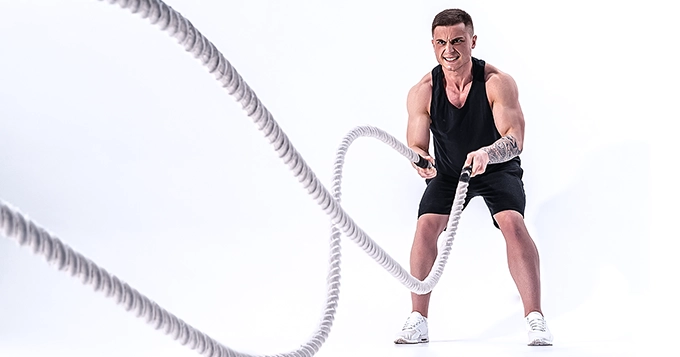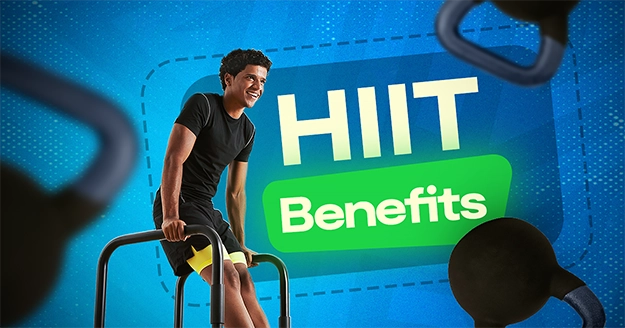What is High Intensity Interval Training?
High Intensity Interval Training or HIIT, is a popular and effective exercise regimen that involves short bursts of intense physical activity followed by short periods of rest or lower-intensity recovery.
You push your pace beyond your comfort zone, which elevates your cardiovascular (cardio) workout to a new level.
This training method is designed to elevate your heart rate and push the limits of your body in a relatively short amount of time. HIIT workouts typically last anywhere from 10 to 30 minutes, making them a time-efficient choice for those with busy schedules.
What are the benefits of HIIT training?
It improves your stamina.
While longer workouts are sometimes advised to increase stamina, evidence suggests that shorter, more intense exercise blocks, such as HIIT sessions, can be more beneficial. According to a 2018 study, a 20-minute HIIT workout can increase endurance twice as much as cycling or jogging.
It helps you burn more fat.
Despite the very small time commitment, HIIT has been shown in a number of other trials to reduce body fat.
HIIT is well known for burning a lot of fat and calories. In reality, by forcing the body to match the demands of the heart’s maximum pace, it is said to burn 13 calories every minute.
It promotes muscle growth.
Conversely, HIIT has been shown to preserve muscle by teaching it to repair and regenerate during a brief period of inactivity. Although high-intensity interval training may help some muscle growth, weight training is still the most effective way to build muscle.
It increases a person’s resting metabolic rate.
Numerous studies have shown how effective HIIT is at raising your body’s metabolic rate for hours after physical activity. In fact, HIIT has been shown by some researchers to boost your metabolism more than weight training or running after exercise.
It keeps your heart healthy.
Numerous studies show that it can lower blood pressure and heart rate in those who are overweight or obese, which are demographics where high blood pressure is widespread.
Eight weeks of high-intensity interval training (HIIT) on a stationary bike was found to lower blood pressure in persons with high blood pressure just as much as traditional, continuous endurance training.
Based on one study published in the European Journal of Preventive Cardiology, individuals with stable coronary artery disease saw a 17.9% rise in VO2 max following HIIT.
VO2 max shows the rate at which the body uses oxygen during exercise. These findings demonstrate the potential benefits of HIIT for heart health and the prevention (or possibly treatment) of stable coronary artery disease symptoms.
It can reduce blood sugar.
According to a review of 50 studies, HIIT decreases insulin resistance better than regular continuous exercise and lowers blood sugar.
Experiments conducted on individuals with type 2 diabetes have shown that HIIT is beneficial in improving blood sugar levels.
After 12 weeks of HIIT, persons with type 2 diabetes had better-managed blood sugar levels, according to research done in Denmark. This could have a significant impact on people with diabetes by assisting them in maintaining healthy blood sugar levels.
Even for those without diabetes, controlling blood sugar levels is beneficial since it keeps energy levels stable and prevents the mid-afternoon slump.
It improves aerobic and anaerobic performance.
HIIT enhances performance in both anaerobic and aerobic exercises, in addition to its many health benefits.
If you practice high-intensity interval training (HIIT) for a few brief sessions per week, your performance during activities such as running with your kids or competing in sports will increase.
It can strengthen your bones.
Since you can perform HIIT exercises virtually anywhere, take advantage of the chance to get some fresh air. Engaging in outdoor exercise allows the skin to absorb essential vitamin D from the sun, supporting the maintenance of strong bones and teeth.
Conclusion
Consider High-Intensity Interval Training (HIIT) for one compelling reason: results.
The best HIIT workout are also quite adaptable, so you can easily modify them to fit your unique schedule and chosen training method. There’s a HIIT workout out there that will work for you, ranging from strength training and running to boxing and rowing.
It is not difficult to begin incorporating high-intensity intervals into your fitness regimen; there are numerous ways to do so.
All you have to do to get started is choose an exercise (bike, jogging, jumping rope, etc.).
After that, you can experiment with different recovery and exercise durations.










